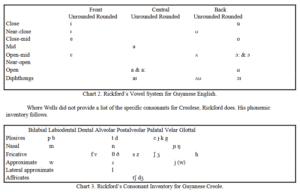What is Guyanese Creole? When asked for an answer to this question many would go as far as to say something similar to “isn’t it something like English but with a broken accent?” However, here on this site we will dive a little deeper and reveal a little truth behind everything “Guyanese.” For one little fact even though most of the words in Guyanese come from British English (known as the ‘lexifier’ language for its contribution to the vocabulary), it also contains influences from languages such as Dutch, West African, Arawakan, and other Caribbean languages. There are still many other languages spoken throughout the country of Guyana. Some languages known to be spoken throughout Guyana beside the English-lexified Guyanese Creole are Hindi, Spanish, Portuguese, Dutch, French, and Aboriginal languages. Another interesting fact is that Guyanese creole is not even called GC by its native speakers. Within the country of Guyana, the natives refer to it as Creolese. Guyana’s population is about 758,000 people, and within that number there are many dialects and varieties of Creolese. When learning about Guyanese Creole or Creolese you will encounter what is called the Creole Continuum. Creole Continuums are used to describe the multiple varieties of Creolese: Acrolect, Mesolect, and Basilect. When speaking Creolese the Acrolect variety is usually used by the speakers of the upper class, the middle class using Mesolect., and lastly Basilect is often heard being spoken by the laborer’s in the rural population, although many people have ranges along the continuum and style-shift according to the situation and context.
| Level of speech | Utterance |
| 5: Acrolect | I told him. |
| 4: | I tool im. |
| 3: Mesolects | A tel im. |
| 2: | Mi tel i. |
| 1: Basilect | Mi tel am. |
Also, a closer look under the language magnifying glass will reveal lexicon, syntax, and phonology also plays a big part in the formation of Creolese.
Phonology: A linguistic study done by Hubert Devonish and Dahlia Thompson (2010) entitled “A concise Grammar of Guyanese Creole (Creolese)” included a set of ten vowels and two diphthongs.

(From Holbrook & Holbrook 2001: https://web.archive.org/web/20180709011520/http://www-01.sil.org/silesr/2002/011/SILESR2002-011.pdf)
| SAE Utterance | GC Transcription |
| the dark | /di dak/ |
| tasty thigh
Tune Attitude |
/testi tai/
/chu:n/ /atich:d/ |
The dental Fricative in Standard American English and the /d/ in GC is pronounced the same. He voiceless dental fricative is pronounced T in GC. There are also occurrences when /t/ changes to the voiceless palatal affricative /ch/ and the notable distinction of the deletion of /r/ in dark within GC, similar to the deletion in many non- standard English dialects. Syntax: Simplification of GC is also present in the syntax. Many aspects of syntax that distinguish lexical ambiguities in SAE are absent in GC. Some of these elements include conjugation between verb tenses and pluralization. In SAE, we use verb conjugations to help further clarify the subject performing the verb (for example: he eat, I eat, and he does, I do). In GC, these distinctions may not be affected by the subject, but by other helping words (Alex M. Balogblin (2011)).
Syntax — Noteworthy sentences
I told him – ‘Mi tel am’
He hit it – ‘i It i/am’
She’s going to the church- ‘Shi gain ah de chuch’ or ‘Shi ah go ah de chuch’
She went to the church – ‘Shi gon/gwan ah de chuch’
She will go to church – ’Shi guh go/gwan ah de chuch’
They don’t want to tell them – ‘Dem nuh wan (fi) tell dem’
She wants to tell her – ’Shi wan (fi) tell er/shi’
The lexicology of Guyanese Creole consists of many words & phrases unique to it, and although hundreds of nouns and necessary labels of an “ Active” ecology have came through Guyana from the languages of identified ethic groups (two Arawakan, six Caribbean, and one Warrau) the Guyanese vocabulary consists of hundreds of every day words known to Guyanese but not other Caribbean (1996xli) (David J. Holbrook and Holly A. Holbrook, 2001).
A go do it- Meaning “I will do it”
Dem a waan sting yu waan bil-literally-they want to string your one bill- Meaning-“they usually want to take money from you
Suurin- a form of courtship (from suitoring, the result of adapting the noun suitor for use as a verb
Holbrook, David J. and Holly A. Holbrook , Guyanese Creole survey report , 2002 , SIL Electronic Survey Reports , Language Assessment, Sociolinguistics
http://guyanachronicle.com/2013/10/13/the-rich-cultural-expression-of-guyanese-creolese
https://www.academia.edu/16398118/Guyanese_English_Creole_A_Sociolinguistic_Analysis



Guyana*
fixed–thanks!
mi tel am testy tai
I’m so happy that this research is being done in showing appreciation of our language
Ok Cuny! only in NY, melting pot. Love this.